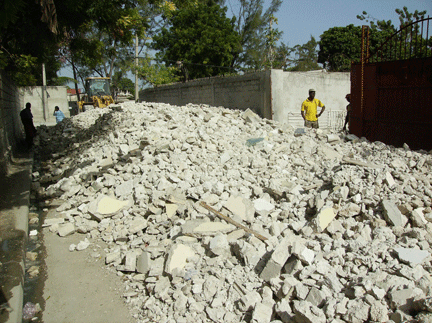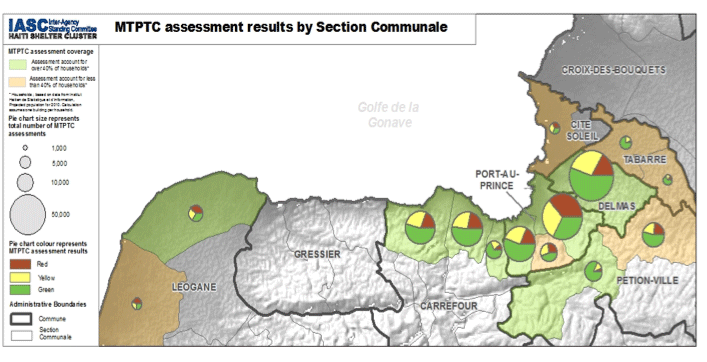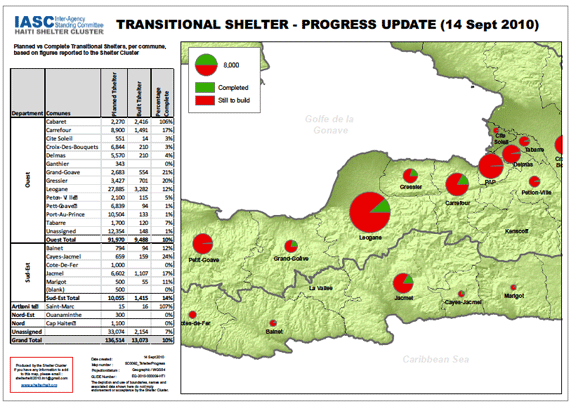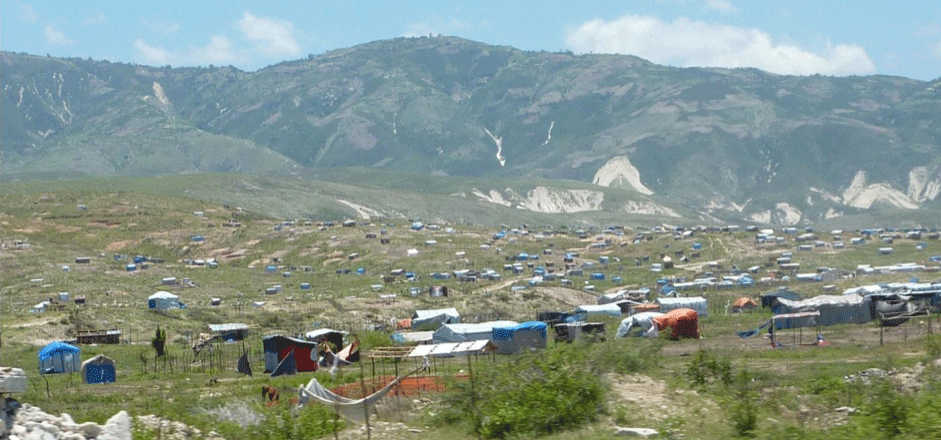Part 2 - What are the challenges?
 Sunday, October 10, 2010 at 11:09AM
Sunday, October 10, 2010 at 11:09AM A three-week investigation by Haiti Grassroots Watch revealed that – contrary to what the government’s silence might indicate – the non-governmental organizations (NGOs), multilateral agencies and foreign government assistance agencies do have a plan for what to do with the 1.3 million refugees living in the country’s 1,354 squalid camps.
Part 1 – Who is in charge and what is the plan? – of our series outlined the plan and also at who is implementing it
This is Part 2 and it takes a more in-depth look at the plan and its challenges
How is it going?
A piece-meal, only vaguely coordinated, and as-yet unofficial “Return and Resettlement Strategy” for Haiti’s 1.3 million refugees appears to have been underway for the past month or two. Interviews, investigations in the field and internal documents obtained by Haiti Grassroots Watch confirm the broad brushstrokes, and also the fact that it is not led by the Haitian government. Instead, agencies pursue their own projects with some loose coordination provided by UN-organized Shelter Cluster staff. [See Part 1 for details.]
So far, a series of camps have been closed, while at others, committees have signed agreements for residents to deals in exchange for vacating the grounds (for example, $63 per person at one camp, six weeks work at $5 a day at another.) Some people have been transferred to planned camps like Tabarre Issa and Corail-Celesse and about 15,000 families have recieved "transitional shelters" or "T-Shelters."

A girl walks by a T-Shelter – metal frame with plastic sheeting walls –
by CHF International and funded by U.S. AID. Courtesy CHF International
In the meantime however, according to a recent New York Times article, at least some impatient private property owners are threatening expulsion. (Many camps are located on private property.) Since March, the Times reported, 28,065 people have been kicked out of camps, and another 144,175 threatened with expulsion.
And while the UN and other humanitarian agencies have repeatedly asked the Haitian government to declare a moratorium on all expulsions, which are illegal according to international conventions, the government doesn’t appear to be too interested in defending the rights of the displaced people.
“I think that while we do everything possible to improve the living conditions people, especially those in the tents, we also need to support the respect for private property,” Ronald Baudin, Minister of the Economy and Finances, and head of the Facilitation Committee for the Reconstruction of Downtown Port-au-Prince, told Haiti Grassroots Watch partner AlterPresse in late August.
And so, it appears that as the Shelter Cluster waits for official approval of the aforementioned strategy document from one or all representations of the Haitian government – the president, the various ministries or the non-elected Interim Haiti Reconstruction Commission, the plan is moving forward. [See Part 1 for more on this]
The Challenges
Here are main elements of the plan and the relevant challenges:
Plan: Move families back to original homes – Challenge: What about the rubble?
The capital and other cities affected by the earthquake are still encumbered with between 20 million and 30 million cubic meters of rubble. So far, only a small amount – estimates range from two to ten percent – has been removed. Delays in funding, and also the fact that there is no single agency coordinating rubble removal indicate that the rubble will be in the way for years to come. One humanitarian agency produced a video called “The Rubble Puzzle” but no agency or ministry has yet determined how to solve that puzzle.

Courtesy of CHF International
Plan: Move families back to home – Challenge: Who will pay for “red” and “yellow” house removal or repairs?
According to the latest tallies from the International Organization for Migration and the Ministry of Public Works (TPTC), there are about 50,000 homes that were marked “red” and need to be destroyed and cleared, and another 54,000 to 64,000 marked “yellow,” meaning they need to be repaired.
Who will pay for and coordinate these two massive public works projects? As of September 24, NGOs had only about 15 percent of the funding needed for the repairs, according to Gehard Tauscher, head of the Shelter Cluster.
 Ministry of Public Works (TPTC) assessment of "red," "yellow" and "green" houses
Ministry of Public Works (TPTC) assessment of "red," "yellow" and "green" houses
Plan: Move families into 135,000 T-Shelters – Challenge: Where to put the shelters?
There are over 300,000 families currently in the camps. According to the IOM, 159,749 families rented their home prior to January 12. The other families say they own their land. NGOs don’t want to give a T-Shelters to a family that does not own the land or at least have a proper, long-term lease.

T-Shelters planned (red) and completed (green) as of September 14, 2010. Note that Léogane is slated to get more than Port-au-Prince. One Shelter Cluster staffer, who asked not to be identified, told Haiti Grassroots Watch NGOs prefer to work there was because "it is easier to deal with the land issue there."
However, Haiti’s land tenure system is “complete disorder that has been going on for 200 years,” according to Bernard Etheart, expert on Haitian land issues and the director of the National Institute of Agrarian Reform. Ever since Haiti’s independence, various dictators have stolen, sold or gaving away land to their families and allies. Haiti has no land registry. [Listen to an interview with Etheart on the issue]
The NGOs are therefore faced with people who say they “own” the land where they lived do not have proper titles, or if it is a good piece of land “there are usually three or four people who produce a title,” Léogane Shelter Cluster Information Manager Deborah Hyde told Haiti Grassroots Watch.
For a renter to get a T-Shelter, he or she needs to be able to produce a lease of at least a year and, ideally, more. Cluster Shelter and NGO staff say they are negotiating leases with the assistance of local elected officials in communities around the country, but there are 159,749 renter families currently in camps.
An October 4 Powerpoint prepared by the Shelter Cluster appeared to deplore the government’s lack of action, noting that
“no land has been made available to host affected population in new camps/ housing areas; land ownership in former neighborhoods is extremely complex; lack of willingness to make unpopular decisions.”
Plan: New, safer homes in better-planned neighborhoods – Challenge: As yet no building code, full funding lacking
Various NGOs as well as the Haitian government have talked about new urban developments with safer homes and proper zoning, and some are moving head with small pilot projects. But hundreds of thousands of families need homes and the funding is not in place. Also, the Ministry of Planning has not yet produced the new building code for which NGOs are reportedly waiting. Most NGOs are loathe to design and build before seeing the code. One NGO director told Haiti Grassroots Watch “now they are saying ‘November’” for its completion.
Plan: Move “leftover” people to the 7,000-hectare tract of land – Challenge: It is currently unsafe
Because of its proximity to denuded mountains prone to mudslides and flooding, until some engineering work and modification is done, the 7,000-hectare piece of land north of the capital is unsafe for permanent settlements.
“They have plans for major camps but assessment of the area shows its not that easy,” Tauscher told Haiti Grassroots Watch and he added that the land is also not ready from a legal standpoint, either.
“To declare it eminent domain is one step but the landowners have to be compensated, you know, so its more complex also on the land ownership side,” he said.
Hundreds of people have set up tents and shacks on the land since the government's announcement.

Make-shift tents and houses on 7,000-hectare tract of land north of the capital. Areas of mudslides can be seen in the background. UN Habitat
Plan: Coordinate policy and execution under one roof
As of October 7, almost nine months after the earthquake, it still appears that no one agency or ministry is coordinating an overall plan for “return and resettlement.” [See Part 1 for details]
To make matters worse, the upcoming elections add another wrinkle.
“I don’t expect major decisions before the elections and I don’t expect them with the new government or whatever government is in place in the very first weeks when the are in power,” Tauscher said.
In addition, in November the Red Cross will hand over Shelter Cluster coordination of the UN Habitat, a UN agency. But an internal document from September 28 presented by Office of Humanitarian Affairs (OCHA) staffer Tania Bernath, an Inter-Cluster coordinator, indicates UN Habitat might not be up for the job.
“It is difficult to understand how a handover from the shelter cluster to UN Habitat will take place. They carry out completely different tasks and their approach to everything is different. UN Habitat has demonstrated almost no ability to coordinate perhaps the most important part of the response. It is also not clear who is in charge of coordinating the yellow, green and red houses…”
Part 1 - Who is in charge and what is the plan?

